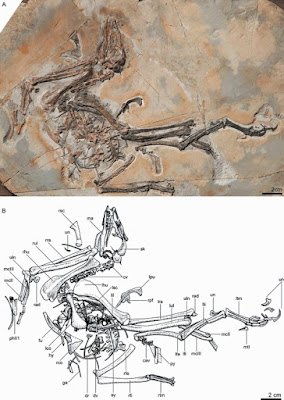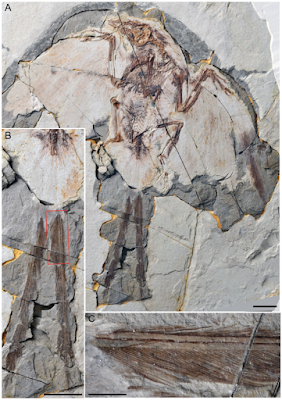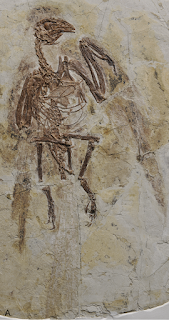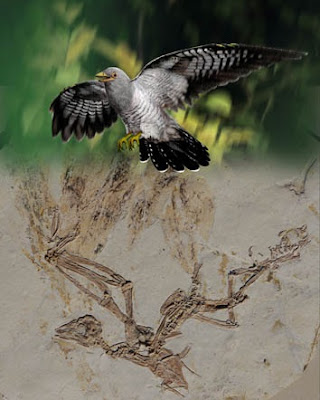[Most Recent Entries] [Calendar View]
Sunday, April 3rd, 2016
| Time | Event | ||||
| 3:17p | [PaleoOrnithology • 2008] Pengornis houi • Insight into Diversity, Body Size and Morphological Evolution from the Largest Early Cretaceous Enantiornithine Bird
Abstract Most of Mesozoic bird diversity comprises species that are part of one of two major lineages, namely Ornithurae, including living birds, and Enantiornithes, a major radiation traditionally referred to as ‘opposite birds’. Here we report the largest Early Cretaceous enantiornithine bird from north-east China, which provides evidence that basal members of Enantiornithes share more morphologies with ornithurine birds than previously recognized. Morphological evolution in these two groups has been thought to be largely parallel, with derived members of Enantiornithes convergent on the ‘advanced’ flight capabilities of ornithurine birds. The presence of an array of morphologies previously thought to be derived within ornithurine and enantiornithine birds in a basal enantiornithine species provides evidence of the complex character evolution in these two major lineages. The cranial morphology of the new specimen is among the best preserved for Mesozoic avians. The new species extends the size range known for Early Cretaceous Enantiornithes significantly and provides evidence of forelimb to hind limb proportions distinct from all other known members of the clade. As such, it sheds new light on avian body size evolution and diversity, and allows a re-evaluation of a previously proposed hypothesis of competitive exclusion among Early Cretaceous avian clades. Keywords: bird evolution; China; Early Cretaceous; Enantiornithes Aves Linnaeus, 1758 Enantiornithes Walker, 1981 Pengornis houi gen. et sp. nov Holotype: IVPP (Institute of Vertebrate Paleontology and Paleoanthropology, Beijing, China). V15336 comprises a nearly complete skeleton preserved in partial articulation (Figs 1–3) lacking only sternum and pelvic bones and parts of the distalmost left forelimb. Etymology: ‘Peng’ refers to a Chinese mythological bird, ‘ornis’ is Greek for bird, and ‘houi’ is in honours of Lianhai Hou, a pioneering palaeo-ornithologist. Locality and horizon: Dapingfang, Chaoyang, Liaoning China; Jiufotang Formation, Early Cretaceous (He et al. 2004). Diagnosis: Four characters are unambiguously optimized as local autapomorphies of the new species in the phylogenetic analysis: premaxillae unfused throughout their length, hooked scapular acromion, a globose humeral head that projects further proximally than the deltopectoral crest (Characters 1:0, 105:1, 107:1, 108:1; Appendices 1 and 2). Zhonghe Zhou, Julia Clarke and Fucheng Zhang. 2008. Insight into Diversity, Body Size and Morphological Evolution from the Largest Early Cretaceous Enantiornithine Bird. Journal of Anatomy. 212(5); 565–577. DOI: 10.1111/j.1469-7580.2008.00880.x HU Han, ZHOU Zhong-He and Jingmai K. O’CONNOR. 2014. A subadult specimen of Pengornis and character evolution in Enantiornithes. VERTEBRATA PALASIATICA. 2014(1); 77-97 | ||||
| 3:36p | [PaleoOrnithology • 2014] Eopengornis martini • Insights into the Evolution of Rachis Dominated Tail Feathers from A New Basal Enantiornithine (Aves: Ornithothoraces)
We report on a new enantiornithine Eopengornis martini gen. et sp. nov. from the lowest horizon of the Jehol Biota in Hebei, China; dated at 130.7 Mya, this is the second oldest avian bearing fossil deposit in the world, recording the First Appearance Datum of Enantiornithes. The new specimen, only the second enantiornithine and third bird reported from this horizon, preserves numerous synapomorphies with the largest Lower Cretaceous enantiornithine Pengornis houi from the Jiufotang Formation dated at 120 Mya. Together, they form a new avian lineage that lasted over 10 Myr, which is longer than any known clade of Lower Cretaceous enantiornithine. Eopengornis reveals new information about basal enantiornithine morphology such as the presence of a metatarsal V, helping to clarify the early evolution of these dominant Cretaceous avians. Furthermore, Eopengornis preserves a previously unrecognized tail morphology: a pair of elongate fully pennaceous rachis dominated feathers. This discovery confirms hypotheses proposing that the rachis dominated racket-plumes in basal birds represent modified pennaceous feathers. We suggest that the ornamental racket-plumes in enantiornithines and Confuciusornis evolved independently from the basal pygostylian condition, which we infer was a tail formed of normal flight feathers.
Systematic palaeontology Aves Linnaeus 1758 Ornithothoraces Chiappe 1995 Enantiornithes Walker 1981 Pengornithidae fam. nov Phylogenetic definition: The most recent common ancestor of Eopengornis martini and P. houi and all its descendants. Type genus: Pengornis IVPP V15336 Zhou, Clarke & Zhang, 2008. Included genera: Eopengornis gen. nov. (present study). Stratigraphic distribution: Huajiying and Jiufotang Formations, 120–130.7 Mya (Zhou, 2006; Jin et al., 2008; Pan et al., 2013). Geographical distribution: Fengning, northern Hebei Province, and Lingyuan and Dapingfang, Chaoyang, north-eastern Liaoning Province, China. Diagnosis: Medium to large enantiornithine birds (minor metacarpal projecting distally farther than major metacarpal; straight scapula; dorsolaterally excavated furcula with rami defining a V; metatarsal IV reduced) with the unique combination of the following characters: upper and lower jaws with numerous small teeth (over ten in the maxilla alone); scapular acromion process hooked; sternum with single pair of trabeculae, intermediate trabeculae absent; xiphial region of sternum defines wide V (xiphoid process absent); short pygostyle with rounded distal margin; cranial surface of proximal humerus flat; ulna 15% longer than the humerus; femur almost as long as the tibiotarsus; fibula almost reaching the proximal tarsals; metatarsal I > 30% the length of metatarsal II; first phalanx of hallux longest pedal phalanx; and pedal claws heterogeneous. Eopengornis martini gen. et sp. nov. Holotype: STM24-1, an almost complete and fully articulated subadult individual preserved in a slab (primarily ventral view; see Supporting Information, Fig. S1) and counterslab (primarily dorsal view; Fig. 1), preserving remiges, rectrices, and contour feathers as an outline of the body. Locality and horizon: Near Luozigou Village, Fengning, Hebei, China. Lower Cretaceous ‘Protopteryx horizon’ (130.7 Mya), the first sedimentary member of the Huajiying Formation (previously also called Dabeigou Formation or Dadianzi Formation) (Jin et al., 2008; Pan et al., 2013). Etymology: The genus name refers to the older age of the new specimen relative to known specimens of Pengornis; the species name is in honour of the late Larry Martin for his numerous contributions to the field of palaeornithology. Diagnosis: A pengornithid enantiornithine bird with the following unique characters: numerous, small, occlusally tapered and slightly recurved teeth in the upper and lower jaws; accessory foramina piercing nasal absent; fibula ends in a rounded expansion; and elongate hallux with metatarsal I and the proximal phalanx each almost half the length of metatarsal II. Xiaoli Wang, Jingmai K. O'Connor, Xiaoting Zheng, Min Wang, Han Hu and Zhonghe Zhou. 2014. Insights into the Evolution of Rachis Dominated Tail Feathers from A New Basal Enantiornithine (Aves: Ornithothoraces). Biological Journal of the Linnean Society. [Special Issue: Celebrating Dinosaur Island] 113(3); 805–819. DOI: 10.1111/bij.12370 | ||||
| 3:37p | [PaleoOrnithology • 2015] Parapengornis eurycaudatus • A New Species of Pengornithidae (Aves: Enantiornithes) from the Lower Cretaceous of China Suggests a Specialized Scansorial Habitat Previously Unknown in Early Birds
Abstract We describe a new enantiornithine bird, Parapengornis eurycaudatus gen. et sp. nov. from the Lower Cretaceous Jiufotang Formation of Liaoning, China. Although morphologically similar to previously described pengornithids Pengornis houi, Pengornis IVPP V18632, and Eopengornis martini, morphological differences indicate it represents a new taxon of the Pengornithidae. Based on new information from this specimen we reassign IVPP V18632 to Parapengornis sp. The well preserved pygostyle of the new specimen elucidates the morphology of this element for the clade, which is unique in pengornithids among Mesozoic birds. Similarities with modern scansores such as woodpeckers may indicate a specialized vertical climbing and clinging behavior that has not previously been inferred for early birds. The new specimen preserves a pair of fully pennaceous rachis-dominated feathers like those in the holotype of Eopengornis martini; together with the unique morphology of the pygostyle, this discovery lends evidence to early hypotheses that rachis-dominated feathers may have had a functional significance. This discovery adds to the diversity of ecological niches occupied by enantiornithines and if correct reveals are remarkable amount of locomotive differentiation among Enantiornithes. Systematic Paleontology Aves Linnaeus, 1758 Ornithothoraces Chiappe, 1995 Enantiornithes Walker, 1981 Pengornithidae Wang et al., 2014 Parapengornis eurycaudatus gen. et sp. nov. urn:lsid:zoobank.org:act:023BF172-3901-4 Holotype: IVPP V18687 (Fig 1), a nearly complete and articulated individual preserved in a single slab, missing only the distal portion of the sternum and some parts of the left hand and right foot, with impressions of the remiges and rectrices. Locality and Horizon: Lingyuan, Chaoyang, Liaoning, China, Jiufotang Formation, Early Cretaceous. Etymology: Parapengornis is composed of the Latin prefix ‘para’ and Pengornis indicating the close relationship between the new taxon and Pengornis. The species name eurycaudatus, ‘eury’ means broad and ‘caudatus’ means tail in Latin, indicating the unique broad and laterally expanded pygostyle of the new taxon. Han Hu, Jingmai K. O’Connor and Zhonghe Zhou. 2015. A New Species of Pengornithidae (Aves: Enantiornithes) from the Lower Cretaceous of China Suggests a Specialized Scansorial Habitat Previously Unknown in Early Birds. PLoS ONE. DOI: 10.1371/journal.pone.0126791 | ||||
| 3:41p | [PaleoOrnithology • 2016] Chiappeavis magnapremaxillo • An Enantiornithine with a Fan-Shaped Tail, and the Evolution of the Rectricial Complex in Early Birds
Highlights • O’Connor et al. name a new pengornithid enantiornithine honoring Dr. Luis Chiappe • The new specimen preserves strong evidence that an aerodynamic tail is present • These new data suggest that Shanweiniao had ornamental feathers • The unique pengornithid pygostyle may possess simple rectricial bulbs Summary The most basal avians Archaeopteryx and Jeholornis have elongate reptilian tails. However, all other birds (Pygostylia) have an abbreviated tail that ends in a fused element called the pygostyle. In extant birds, this is typically associated with a fleshy structure called the rectricial bulb that secures the tail feathers (rectrices). The bulbi rectricium muscle controls the spread of the rectrices during flight. This ability to manipulate tail shape greatly increases flight function. The Jehol avifauna preserves the earliest known pygostylians and a diversity of rectrices. However, no fossil directly elucidates this important skeletal transition. Differences in plumage and pygostyle morphology between clades of Early Cretaceous birds led to the hypothesis that rectricial bulbs co-evolved with the plough-shaped pygostyle of the Ornithuromorpha. A newly discovered pengornithid, Chiappeavis magnapremaxillo gen. et sp. nov., preserves strong evidence that enantiornithines possessed aerodynamic rectricial fans. The consistent co-occurrence of short pygostyle morphology with clear aerodynamic tail fans in the Ornithuromorpha, the Sapeornithiformes, and now the Pengornithidae strongly supports inferences that these features co-evolved with the rectricial bulbs as a “rectricial complex.” Most parsimoniously, rectricial bulbs are plesiomorphic to Pygostylia and were lost in confuciusornithiforms and some enantiornithines, although morphological differences suggest three independent origins. Keywords: Pengornis, rectrix, tail, Enantiornithes, Pygostylia, Jehol, Cretaceous Jingmai K. O’Connor, Xiaoli Wang, Xiaoting Zheng, Han Hu, Xiaomei Zhang and Zhonghe Zhou. 2016. An Enantiornithine with a Fan-Shaped Tail, and the Evolution of the Rectricial Complex in Early Birds. Current Biology. 26(1); 114–119. New enantiornithine bird with an aerodynamic tail found in China http://phy.so/371119857 via @physorg_com |
| << Previous Day |
2016/04/03 [Calendar] |
Next Day >> |







